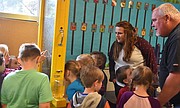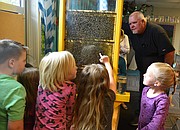Honey bees display intrigues Plains kindergarten students
“When I say BZZZZZZ, it makes my tongue tickle!”
This is one of the many observations made by Katie Hillerman’s Plains kindergarten class Monday morning as they had a live beehive unveiled in their classroom.
Beekeeper Darin King constructed a modified Langstroth-style hive, with vertical removable frames, but only one frame deep, with safety glass on the outside, so the bees’ activities can be observed. A vacuum cleaner hose provides the bees an exit through a window for foraging outdoors.
King brought in the bees Saturday. “They were upset after riding in the back of a pickup for miles,” he said. “They were so loud you could hear them as you walked in the room.” By Monday, they had calmed, but could still be heard by putting one’s ear to the screened holes in the frame, a chance to safely listen into a busy world ordinarily too dangerous to approach without special protection.
Hillerman said her class and Jill Rice’s fourth-graders are studying bees. Each kindergartener is partnered with a fourth-grader for science activities every afternoon. The older students are creating Power Point presentations and the youngsters are making bee books.
KING IS attempting to get the hive to make a queen so the kids can see the process of the queen cell developing. But there may be one in there already, he said, based on their quiet buzzing — they are much quieter when there’s a queen. Queens can be developed from fresh eggs in sixteen days, but if there is no queen currently, eggs are not made, so he may need to bring in eggs from another hive.
Ordinarily, a queen is made deep in a hive and impossible to see. But having glass on both sides of the frame will enable the students to watch if a queen develops.
“Look, there’s a drone!” said one savvy kindergarten scientist, pointing to a larger, darker colored hive member. The glass made very brave people able to closely observe even the hairs on the bees’ heads.
The kids are in good company with the beekeeper. King has been keeping bees for two years. “I learn something every day,” he said.







